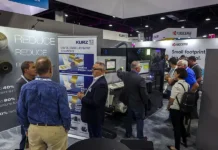By Mark Porter, Dienamic MIS Software, Inc.
Successful businesses continually are looking for ways to increase sales and profits. Looking for new products, new processes and new markets are common approaches to meeting these objectives. These methods often are costly and time intensive. There are significant increases in sales and profits that can be obtained much more easily, and they are right under your nose.
There are significant increases in sales and profits to be had by simply taking control of the business in the following ways:
- Determine the true costs of running the business
- Increase revenue from existing clients
- Maximize efficiency and reduce waste
- Eliminate mistakes that turn good jobs into bad jobs
Determine the true costs of running the business
It is vital to know what the true costs are to know what profits will be on each job. This allows the finisher to determine which jobs to aggressively seek and which jobs to refuse. Budgeted hourly rate software is available that will help determine the true cost to operate each machine, and productivity analysis software can determine the true speeds and times achieved by the equipment. These true costs and standards can then be used in an estimating system that will determine the true cost of each quote produced.
We all know: Sales – Costs = Profits. If we don’t know our costs, how do we know our profits?
Increase revenue from existing clients
Of total sales, how much is created by changes to the original job specifications received from the client? Every print finisher/bindery experiences these changes. The estimate was to ship bulk in cartons and now the client wants to shrink wrap in 50s. The management of these changes can have a significant effect on the bottom line by collecting the charges from the customer or not incurring an additional cost the business ends up paying.
The nature of today’s business is to focus on quality and delivery time, causing companies often to miss many legitimate extra charges. These charges add up quickly. Let’s say a finisher has $2,000,000 in sales and that 15% of the work is for changes to the original order. That represents $300,000 in sales, if they tracked and rebilled them. By only capturing 50% of these charges, $150,000 is being left on the table.
Finishers must take an approach to their business, much like the housing industry. These changes are happening, and someone has to pay for them – the business or the client. The estimate represents the original blueprint, and a changes management system allows the business to capture these legitimate chargeable changes that happen during the production process.
The most effective way to accomplish this is through an order entry system. By computerizing the order entry process, finishers can lock in the original job specifications for the order – those that match the estimate. As the job is produced and changes are requested or needed, the order entry system date, time, employee and reason stamps the changes. The system will generate a change form that is sent to the customer with the price and the approval. The chargeable changes are automatically added to the invoice and documented to a report that management can review at the billing stage. The business is now tracking all extra charges and providing the backup to the customer to substantiate the charges and increase the likelihood of collecting them. This will either increase sales or reduce costs – every change made to a job is costing money to either the customer or the business.
Maximize efficiency and reduce waste
The easiest way to maximize efficiency and reduce waste is to make people accountable for the time and materials they use. If an employee knows that he/she can be questioned on the length of time that it took to perform a task or the amount of material used to produce a job, be assured they will be productive. Employee performance can be compared to identify employees who need more training or supervision. This can only make employees more efficient and have a positive effect on the bottom line.
The benefits of accountability are tremendous. Even a small 5% increase in productivity and decrease in waste can mean a significant increase in profits. If we use the same $2,000,000 finisher that has $1,800,000 in costs – a 5% change is $90,000.
By placing computers on the plant floor, employees are required to be accountable for every minute of their day and every piece of material they use on every job. This also tracks the time and utilization of the equipment. It’ll tell how much time was spent on running, makereadying, cleaning, repairing, maintaining or waiting in any time period. With computers on the plant floor, not only are employees sending information to the office, but the office is sending information to them in real time. This means changes made to orders, changes in scheduling can be communicated to the plant immediately in real time to ensure costly mistakes are not made.
Empower employees with technology that will benefit them and the business.
Eliminate mistakes that turn good jobs into bad jobs
Nothing is more frustrating than receiving a nice job and then losing money on it due to preventable mistakes: last-minute changes that don’t make it onto the job jacket in time, changes that are not well documented and missed or past mistakes that are repeated. Technology today can help prevent costly mistakes with applications in the following areas:
- Electronic order entry
- Customer profiling
- Job notes
- Problem history
Electronic order entry
Although there seems to be a reluctance to get rid of a physical job bag completely, as it is required to hold certain items, the reliance for it to provide information to plant employees should be questioned. The plant should be using an electronic version of the order. This ensures all employees always will have access to the most current job information. The information on the electronic order is always updated in real time – the minute a change is made in the office, it is immediately reflected on the electronic order. Employees eliminate wasted time looking for or inquiring about the correct job specifications. The electronic order will be linked to job notes, customer profile and problem history for that specific job.
Customer profiling
Customer profiling allows details specific to a customer, including production and shipping details, and even how the president takes his/her coffee, to be entered. Any piece of information that will ensure the customer’s work is produced exactly as expected, or procedures, should be entered. This will eliminate errors, improve quality and provide the greatest customer satisfaction.
This information is available to all employees at all stages of administration and production. A specific employee no longer has to be relied upon to know the finer details of a customer’s requirements. A great example is if the shipper is looking at a skid with 11,000 pieces on it and the job bag that states the quantity is 10,000. If the shipper looks at the profile and sees the customer accepts 5% overs, they can ship 10,500 which maximizes revenue and holds the other 500 back, which could be sold to the customer at a later date.
Job notes
A description that shows cryptic notes or shortforms that no one understands will only lead to costly mistakes. Software allows electronic notes to be attached and automatically warns anyone looking at that job that there are notes. With plenty of space to enter detailed notes and warnings that tell employees the notes exist, there is no way employees can miss vital information that will determine the success on a job.
Problem history
As the old saying goes, “You are not a fool for making a mistake – only when you make the same mistake twice.” Making preventable mistakes is the most frustrating way to lose money. If problems are not recorded and attached while producing a job, the same mistakes likely will be repeated. These problems can be seen at the estimating stage. Estimates can be adjusted. Issues can be reviewed when the job comes in, and issues that caused problems last time before the job was accepted can be reviewed at the end of a job to help analyze what went wrong and what can be learned. The system also is good at documenting issues on jobs that are going wrong to try to limit liability. The system allows photos and video of the problems to be attached as proof. It can be used as a relationship building tool to explain to customers how they can provide their jobs for the best most economical results.
The system also is a database of problems and solutions that can be used generically for common situations that may occur in the plant – finding previous solutions to those problems.
Automating the company in the office and plant with the proper software and hardware can save tens, if not hundreds of thousands of dollars each year by helping finishers know their true costs, maximizing their productivity, minimizing waste and preventing mistakes with real-time data to help them make more profitable decisions.
Mark Porter is president of Dienamic Software MIS Inc. Porter can be reached at mark@dienamicmis.com. Learn more at www.dienamicmis.com.





